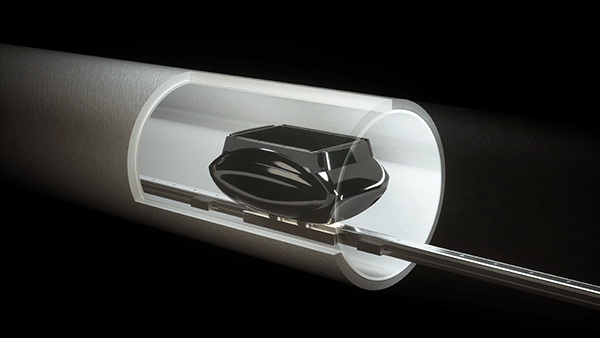What if the next time you ordered groceries they arrived via a vast underground network of pipes, hurtling toward you on a magnetic wave?
Sounds like something lifted straight from science fiction, doesn’t it?
Well, for Phill Davies, the co-founder of UK start-up Magway, it’s an entirely realistic, if radical solution to the huge environmental impact of online delivery in the UK.
Currently, though our growing e-commerce addiction might be convenient, it comes at a huge cost for the planet. For every tonne of parcels currently loaded onto a fossil fuel-powered HGV, each kilometre travelled is another 105g of toxic carbon released into the atmosphere, according to calculations by NGO Tree Nation.
Then bear in mind that around 3.6 billion packages are delivered each year, travelling up to 80km an hour on average – a volume that’s expected to double in the next five years – and the scale of the environmental impact starts to become clear.

But with underground delivery pipes we’d virtually eradicate this impact, says the incredibly passionate Davies. There’d be no fuel, no driver, and no engine belching out toxic emissions, he points out. “Then there are the current issues of road safety with these deliveries, as well as congestion and road maintenance. We can help with all of that.”
But, how on earth would it work? Well, if the idea of electromagnetics as a mode of transport sounds a bit familiar, that’s because it is. Maverick entrepreneur Elon Musk first mentioned his idea for a ‘Hyperloop’ back in 2012, a sealed system of tubes through which people or goods could be propelled at hypersonic speeds.
Davies’ co-founder Rupert Cruise was one of those even drafted in by Musk to draw up initial designs. But while this so-called ‘fifth mode of transport’ remains in its conceptual stages, using the same technology to transport parcels is within our grasp already.
“If you had two magnets, and put the like poles together and saw how they repel each other – that’s the force we’re talking about,” says Davies. Riding that magnetic force will be carriages, big enough to hold the equivalent of the plastic grocery totes your weekly shopping arrives in and powered by electromagnetic motors. “Through algorithms and control systems we can control the speed and force that we use on that carriage.” And also, of course, direct it to the right address.

To begin with the team are planning a series of shorter routes, starting with West London. They’re currently in talks to create a nine-kilometre pipe that runs from Willesden Junction to the Thames, taking in Westfields, Olympia, Earl’s Court, Shepherd’s Bush and Paddington along the way. “That would service over 400,000 households and more than one million people,” says Davies.
Initially this underground network will deposit packages at local distribution hubs, but as new houses, offices and flats are built there’s no reason they can’t come equipped with a built-in pipe in their basement, suggests Davies.
The idea is that big supermarkets, retailers or even the Royal Mail will buy capacity on the network. And given that each pipe has the capacity to transport the equivalent load of 40,000, 40ft HGV containers per week, there’s space for all. Even if Ocado – one of Magway’s consortium partners – sent every single one of their deliveries on a single pipe, it would use less than two per cent of the capacity on a single pipe going in one direction, due to the speed at which parcels can move through.

This idea isn’t entirely new, points out Davies. In the 1860s, the London Pneumatic Dispatch Railway (LPDR) used to send both people and parcels whizzing (well, at 30mph) underneath the capital through a cast iron pneumatic tube. Yes, the scale of the network he and the team at Magway are envisaging is a radical solution, agrees Davies. But that isn’t a drawback.
As Davies puts it: “We’re not going to solve this by doing the same old stuff. The railways were once radical, commercial air travel was once radical, we need radical solutions, we’re killing the planet.”
Three more ‘green delivery’ innovations to watch out for
The electric cargo bike
Electric cargo bikes are “the most promising innovation” when it comes to the future of green grocery deliveries, according to climate solutions charity Ashden. According to European research, these two-wheeled alternatives to the HGV have capacity to fulfil 10-15 per cent of all online deliveries going forward, with local authorities from Bradford to Bristol currently trialling the technology. In 2019, the Co-op even began delivering with a fleet of zero emission e-cargo bikes from one London branch while veg box company Riverford is trialling them in Oxford. “What we need now are more detailed plans from central government, and the release of more resources and delegated powers so that local authorities can create the right infrastructure in each area that will enable bikes and electric van deliveries to thrive,” says Ashden’s CEO Harriet Lamb.
The drone
Four years after retail giant Amazon made its first commercial drone delivery in the UK – from its fulfilment centre in Cambridge to a local resident, within 13 minutes of the order being placed – there are signs that these unmanned aerial bots could soon be taking a more mainstream role in deliveries across the UK. In April, Tesco announced a drone delivery trial that would see small baskets of groceries dropped off at customer doorsteps in County Galway. Flying at 50mph the drones can carry up to 4kg of shopping at any one time, carefully lowering down their small cargo in what’s known as a cassette. Over half of people expect drone deliveries to be commonplace inside three years, according to a European aerospace study in May, with investment in the technology accelerated by the pandemic.
The zero-emission van
Though vans and HGVs might clog up our roads, there’s little chance of phasing them out entirely anytime soon. But with news earlier this month that the government is to place a ban on new petrol vans by 2030, the efforts to roll out new electric alternatives have been brought to the fore. In April, Vauxhall unveiled the Vivaro-e, an electric version of its flagship commercial delivery van, capable of travelling for 188 miles per charge, and carrying 1,226kg at any one time. And in November, international carrier DHL launched the first 16-tonne fully electric truck to travel on UK roads, in what manufacturer Volvo called “a powerful step towards more sustainable city distribution”.










if this becomes a reality and we have to isolate in future in our bubbles, we are just a hair’s breath step away from ‘The Machine Stops’ sci-fi story by E. M. Forster (1909). Sobering thought…..